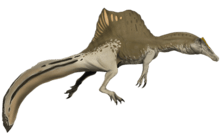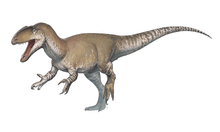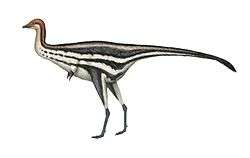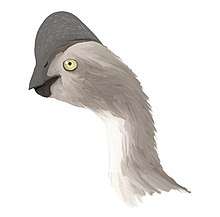Metriacanthosauridae
Metriacanthosauridae is an extinct family of theropod dinosaurs that lived from the Middle Jurassic to the Early Cretaceous.[1] When broken down into its Greek roots, it means "moderately-spined lizards". The family is split into two subgroups: Metriacanthosaurinae, which includes dinosaurs closely related to Metriacanthosaurus, and another group composed of the close relatives of Yangchuanosaurus. Metriacanthosaurids are considered carnosaurs, belonging to the Allosauroidea superfamily. The group includes species of large range in body size. Of their physical traits, most notable are their neural spines.[2] Their fossils can be found mostly in the Northern hemisphere. Metriacanthosauridae is used as a senior synonym of Sinraptoridae.
| Metriacanthosauridae | |
|---|---|
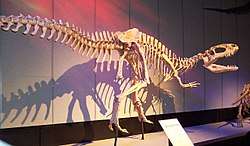 | |
| Sinraptor dongi, Royal Tyrrell Museum | |
| Scientific classification | |
| Kingdom: | Animalia |
| Phylum: | Chordata |
| Clade: | Dinosauria |
| Clade: | Saurischia |
| Clade: | Theropoda |
| Infraorder: | †Carnosauria |
| Superfamily: | †Allosauroidea |
| Family: | †Metriacanthosauridae Paul, 1988 |
| Type species | |
| †Megalosaurus parkeri Huene, 1923 | |
| Subgroups | |
| |
| Synonyms | |
| |
Diagnostic traits

Metriacanthosaurids share the following unambiguous synapomorphies among allosauroids:[1]
- A short or absent anterior ramus of the maxilla (also found in Carcharodontosaurids and Piatnitzkysaurids).
- The laterosphenoid articulated on the frontal and postorbital.
- A squamosal without constriction of the lower temporal fenestra. (also found in megalosauroids)
- A flange on the squamosal covering the quadrate head laterally.
- A well-defined longitudinal groove on the lateral side of the dentary housing a row of neurovascular foramina.
- Broad, well developed spinopost-zygapophyseal lamina on the axis.
- A manus shorter than the forearm.
- Subrectangular and sheet-like neural spines of middle caudal vertebrae.
- A manus without digit V or the phalanges of digit IV (also found in Neovenatorids).
- A heart-shaped cross section of the ilium's paired midshafts (also found in Coelophysids).
- Fused distal end of the ischium (also found in Neovenatorids and basal tetanurans).
Metriacanthosaurines share the following synapomorphies among metriacanthosaurids:[1]
- The anteroventral border of the maxillary antorbital fenestra being demarcated by a raised ridge (also found in Eoraptor, Coelophysids, Masiakasaurus, Marshosaurus, and Compsognathus).
- A pronounced ventral keel on the anterior dorsal vertebrae (also found in Condorraptor, Piatnitzkysaurus, Carcharodontosaurus and many megalosaurians).
- A straight posterior margin of the iliac postacetabular process.
- The angle between the long axes of the pubic shaft and boot being less than 60 degrees.
- A ventrally curved ischial shaft (also found in Coelophysids, Eustreptospondylus, Afrovenator, Megalosaurus and Compsognathus).
- A bulbous fibular crest on the tibia (also found in Sinosaurus).
Classification
Carrano, Benson & Sampson (2012) noted that the name Metriacanthosauridae should be used as it has priority over Sinraptoridae.[1] Cladistically, Sinraptoridae had been latest defined in 2005 by Paul Sereno as the most inclusive monophyletic group that contains Sinraptor dongi and all species closer related to Sinraptor than to either Allosaurus fragilis, Carcharodontosaurus saharicus, or the house sparrow (Passer domesticus).[3]
Furthermore, the 2012 study named a new subfamily Metriacanthosaurinae to include all metriacanthosaurids more closely related to Metriacanthosaurus than to Yangchuanosaurus. A much larger phylogenetic analysis found the basal megalosauroid Xuanhanosaurus as the basalmost metriacanthosaurid.[4] Both Poekilopleuron and Lourinhanosaurus were recovered outside the family, and many taxa within the Metriacanthosauridae were in polytomy. However, the position of Xuanhanosaurus and Poekilopleuron is very unstable, and their exclusion from the analysis gave more resolved and stable cladogram. The cladogram presented here follows that study.[1]
| Orionides |
| ||||||||||||||||||||||||||||||||||||||||||||||||||||||||||||||||||||||||||||||
Palaeobiogeography
Metriacanthosauridae fossils have only been found in modern Europe and Asia, parts of the prehistoric landmass Laurasia. From those found in Asia, most are from China, with a few discoveries in Thailand and other Asian countries. The group is thought to have originated in Asia and spread westward to Europe. Yangchuanosaurus has only been found in Yangchuan, Sichuan, China. Metriacanthosaurus has been found in Northern Europe. Similar to Yangchuanosaurus, Sinraptor has been found in Sichuan, but also in Xinjiang. In 2008, Xu and Clarke described a large tooth found in the Junggard Basin in Xinjian, China, belonging to a large sinraptorid.[5] Siamotyrannus has been found exclusively in Thailand. Shidaisaurus has been found in Yunnan,China.
References
- Carrano, M. T.; Benson, R. B. J.; Sampson, S. D. (2012). "The phylogeny of Tetanurae (Dinosauria: Theropoda)". Journal of Systematic Palaeontology. 10 (2): 211–300. doi:10.1080/14772019.2011.630927.
- Bailey, Jack Bowman. "Neural Spine Elongation in Dinosaurs: Sailbacks or Buffalo-Backs?" Journal of Paleontology, vol. 71, no. 06, 1997, pp. 1124–1146., doi:10.1017/s0022336000036076.
- Sereno, Paul. "Sinraptoridae". Taxon Search. Archived from the original on 17 July 2011. Retrieved 12 December 2010.
- Benson, R.B.J., Carrano, M.T and Brusatte, S.L. (2010). "A new clade of archaic large-bodied predatory dinosaurs (Theropoda: Allosauroidea) that survived to the latest Mesozoic". Naturwissenschaften. 97 (1): 71–78. Bibcode:2010NW.....97...71B. doi:10.1007/s00114-009-0614-x. PMID 19826771.CS1 maint: multiple names: authors list (link) Supporting Information
- Xu, X., and J. M. Clark. "The Presence of a Gigantic Theropod in the Jurassic Shishugou Formation, Junggar Basin, Western China." Vertebrata PalAsiatica, 46: 158–160. www.ivpp.cas.cn/cbw/gjzdwxb/xbwzxz/200811/W020090813369286986655.pdf *.
External links
| Wikispecies has information related to Metriacanthosauridae |



